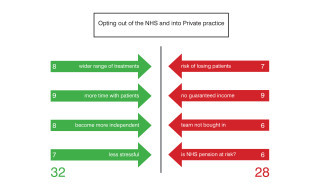 Kerrie Hibbert explains how you can take a more structured approach when dealing with and making decisions within your dental practice.
Kerrie Hibbert explains how you can take a more structured approach when dealing with and making decisions within your dental practice.
Originally created by Kurt Lewin in the 1940s, Force Field Analysis is a simple yet powerful decision-making tool that can help businesses look at the bigger picture, by analysing all the forces impacting on a change to make better-informed decisions about their future strategy.
It works by helping you to understand the relative pros and cons that will affect your decision on whether to move forward with a particular idea or project and, if you do, what actions you should take as a result of that decision.
You start by listing all of the factors (forces) for and against your decision or change. You then allocate a weighting score against each factor based on its influence. At the end you add up the scores for and against the change to get an understanding of how easy or difficult it will be to achieve.
Once you have a better understanding of the forces affecting your decision, you can use your analysis for two purposes:
- To decide whether or not to go ahead with the change
- To increase your chance of success by strengthening the forces supporting the change as well as manage or mitigate the forces against the change.
To carry out Force Field Analysis, do the following:
- Get a sheet of blank paper or a flip chart
- Draw a line down the middle of the page and at the top put a brief description of the change you are proposing
- List the positive forces that would drive the project forward on the left-hand side and the restraining forces against the project moving forward in a column on the right-hand side.
As you do this, consider the different elements that might affect the outcome of the project:
- What costs might be involved?
- What are the business benefits of the change?
- What other risks might be involved?
- How easy will it be to make the change?
- Would you have the support of your team?
- Do you have the skills and resources required?
For example…
Imagine you are an NHS practice and you are considering the move to becoming a fully private practice. Your Force Filed Analysis might look a bit like the above (this list is not exhaustive, but gives you an idea).
The scores in this example are slightly in favour of going ahead with the transition, but there are lots of barriers to reduce for you to feel more confident that the move will be a successful one. So the question is, are there any actions you can take to address or mitigate the con forces before you make a final decision?
In this instance, you might look at the following:
- Carrying out an analysis of your local demographics to see if the profile of your potential customer base is more or less inclined to pay for their dental treatment privately
- Working with an experienced adviser (such as Practice Plan) who can help you work out how many patients you need to retain for the transition to private dentistry to be feasible and how you might introduce a membership plan into the practice
- Holding team meetings to explain in more detail, the benefits of going private and addressing any concerns
- Getting specialist advice on what would happen to your NHS pension in the event of you going fully private.
Carrying out these actions could potentially lessen the restraining forces and pave the way for you to go ahead with your plans, or provide you with the information that confirms whether there are too many risks involved. Either way, you will be making a better-informed structured decision.
Contact Kerrie for further advice and support on [email protected] or visit www.practiceplan.co.uk/nhs.


